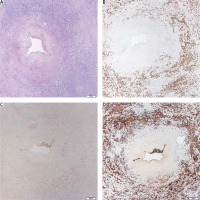Introduction
Lung adenocarcinoma is the most common type of lung cancer, accounting for 40% of cases [1]. It typically metastases to the other lung, brain, bones, liver, and lymph nodes, but metastases to unusual locations, including ureters, are also possible. Here, we present a case of pulmonary adenocarcinoma the first clinical manifestation of which was spread to the ureter, along with a review of the literature on lung cancer ureteral metastases.
Case report
A 74-year-old woman was admitted to the emergency department because of stomach ache and constipation for 3 days. She had a history of resection of the sigmoid colon due to colorectal cancer, followed by adjuvant chemotherapy. Computed tomography scan revealed right-sided hydronephrosis, dilatation of the proximal part of the right ureter to a diameter of 26 mm, thickening of the wall of the renal pelvis and ureter, confluent infiltrative masses in the lower lobes of both lungs, and a tumour in the anterior acetabulum of the left hip, leading to the suspicion of metastatic urothelial carcinoma. The ureterorenoscopic biopsy of the right ureter was complicated by its rupture, so the kidney and the proximal ureter were excised. Gross examination revealed a grey, solid mass infiltrating the intramural proximal and central part of the ureter, penetrating the surrounding adipose tissue. Histologically, the wall of the ureter showed solid infiltration by epithelioid cells with marked atypia, with massive lymphovascular invasion. Urothelial epithelium remained intact. Tumour cells expressed CK7, TTF1, SMAD4, and PD-L1 (70% of cells) but not CK20, PAX8, GATA3, WT1, p63, p40, prostein, mucicarmine, synaptophysin, ROS1, or ALK-Bond (Fig. 1). Metastatic lung adenocarcinoma was diagnosed, and the patient was referred for palliative treatment but died 3 weeks after diagnosis.
Fig. 1
Haematoxylin-eosin staining and immunohistochemical staining of ureteral metastatic lung carcinoma (A–D), low-power histopathological examination slide of transverse section of the ureter with intramural involvement of lung cancer metastasis (×2, HE) (A), TTF1 positive nuclear staining in cancer cells (×2) (B), GATA3-positive nuclear staining in urothelial epithelium, negative in cancer cells (×2) (C), CK7-positive staining in urothelial epithelium and in cancer cells (×2) (D)

Discussion
The knowledge of lung cancer metastatic sites is of great clinical importance, particularly due to its high prevalence and frequent diagnosis at the disseminated stage. A study on 10,464 non-small cell lung carcinoma (NSCLC) cases reported that single distant metastases were localized in bone (22.3%), lung (19.9%), brain (15.8%), and liver (5.8%), while multiple distant metastases predominantly affect bones and liver [2]. Among 729 metastatic lung cancer cases, the most common metastatic sites were bone (34.3%), lung (32.1%), brain (28.4%), adrenal gland (16.7%), liver (13.4%), and extrathoracic lymph node (9.5%) [3]. Nevertheless, NSCLC may spread to virtually any site. For metastases to the urinary system, the most common location is kidney (1–4% of all lung cancer metastases) [4], while bladder, ureter, and urethra involvement occur sparsely. importantly, the sites of lung cancer metastases carry prognostic information. Isolated metastases to the lungs have unequivocally the best prognosis. However, involvement of liver, adrenal glands, or uncommon locations is associated with poor outcomes [2–4]. This most likely includes ureter, an extraordinary metastatic site. In a systematic review of 295 ureteral metastases, the most frequent primary sites were prostate, bladder, breast, and intestines (19%, 17%, 14%, and 13%, respectively). Lung cancer metastases were identified in 5 cases (2%) [5]. Searching PubMed with the following keywords: ureter, ureteral, lung cancer, and metastasis, identified 9 publications after exclusion of unavailable or non-English full texts as well as those reporting direct ureteral involvement (Table 1) [6–13]. Two of these were autopsy studies: one reported 2 cases of lung cancer ureteral metastases (and 35 of other origin) among 11,698 patients [14], and the other identified 3 such cases among 3200 patients [15]. Three possible mechanisms of metastatic involvement of the ureter were postulated [13, 16, 17]. Firstly, metastases to the ureter are most often located in a well-vascularized longitudinal area of the periureteral adventitial layer. Alternatively, only some layers of the ureteral wall may be involved (e.g. the muscular layer), which may result from the involvement of vessels perpendicular to the long axis of the ureter. Finally, neoplastic cells may infrequently be implanted in the sub-epithelial region, forming a nodule, which is most likely caused by the penetration of cancer cells into the lamina propria by perforating arterioles. Nephroureterectomy is the treatment of choice for ureteral metastases, while palliative chemotherapy is offered to ineligible patients [7, 9–12, 15].
Table 1
Details of cases of lung cancer metastases to the ureter reported in the literature
| Publication | Number of cases | Age | Ureter site | Gender | Part of the ureter involved | Histopathological diagnosis | Treatment |
|---|---|---|---|---|---|---|---|
| Fitch et al. [6] | 1 | 49 | Right | Male | 1/3 lower | Squamous cell carcinoma | Nephroureterectomy |
| DiPietro et al. [7] | 1 | 67 | Left | Male | 1/3 middle | SCLC | Unknown |
| Ren et al. [8] | 1 | 61 | Left | Male | 1/3 lower | Adenocarcinoma | Nephroureterectomy with partial cystectomy |
| Wang et al. [9] | 1 | 48 | Right | Male | Unknown | SCLC | Chemotherapy |
| Kodama et al. [10] | 1 | 76 | Right | Male | 1/3 middle | Adenocarcinoma | Chemotherapy |
| Dooldeniya et al. [11] | 1 | 77 | Right | Male | 1/3 middle | NSCLC | Palliative care |
| Shen et al. [12] | 1 | 37 | Left | Male | 1/3 upper | Adenocarcinoma | Nephroureterectomy |
| Babaian et al. [14] | 2 | Unknown | Unknown | Unknown | Unknown | Unknown | Unknown |
| Cohen et al. [15] | 3 | Unknown | Unknown | Unknown | Unknown | Unknown | Unknown |








